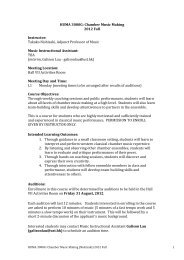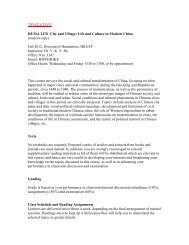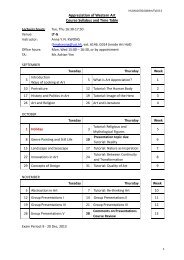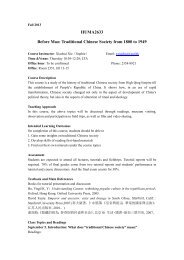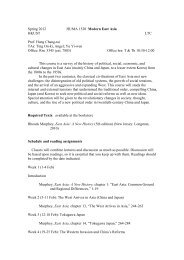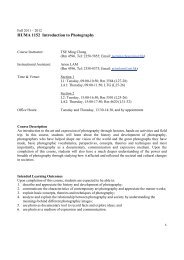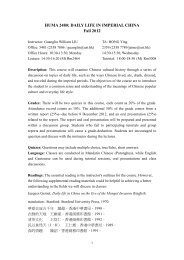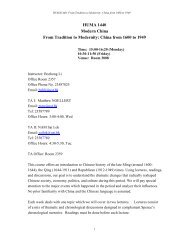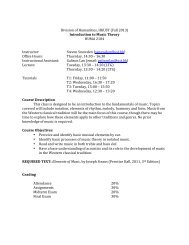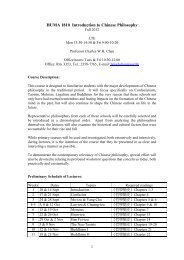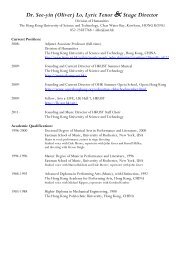HUMA2420 Late Imperial China å¸å¶ä¸åä¸å¾æ - Division of ...
HUMA2420 Late Imperial China å¸å¶ä¸åä¸å¾æ - Division of ...
HUMA2420 Late Imperial China å¸å¶ä¸åä¸å¾æ - Division of ...
Create successful ePaper yourself
Turn your PDF publications into a flip-book with our unique Google optimized e-Paper software.
<strong>Division</strong> <strong>of</strong> Humanities, HKUST Fall 2011<strong>HUMA2420</strong> <strong>Late</strong> <strong>Imperial</strong> <strong>China</strong>帝 制 中 國 中 後 期 : 隋 至 清Instructor: DENG Xiaonan 鄧 小 南Time: Mon 13:30--14:50 and Fri 9:00--10:20Classroom: Room 2306Office:Tel.:E-mail: dengxiaonan50@gmail.comOffice hours: Mon. 15:00 –16:30Teaching Assistant:Course website:Course objective and description:The course will provide the students with a brief overview on the History <strong>of</strong> middle andlate imperial <strong>China</strong> from the Sui to the Qing Dynasties (approximately from the sixth tonineteenth centuries. General approaches to the understanding <strong>of</strong> <strong>China</strong>’s History will beintroduced and a variety <strong>of</strong> historical perspectives will be given. It will be a basicintroduction to Chinese civilization and it will cover the essential facts in the relevantperiods. We will have Power Points for the course, and will encourage the students to actinitiatively in and out <strong>of</strong> our class.Intended learning outcomes:On successful completion <strong>of</strong> the course, students will be able to:1. Cultivate strong interest about Chinese history2. Develop a historical understanding <strong>of</strong> the Chinese civilization;3. Catch up the main trend <strong>of</strong> the middle and late imperial Chinese history;Topics to be covered in this course:Week/ 1.5h X 21 Introduction1.1 Reunification <strong>of</strong> the Chinese Empire in the Sui Dynasty (581-618)1.2 From the Rule <strong>of</strong> Emperor Taizong to the Rule <strong>of</strong> Xuanzong2.1 The Openness <strong>of</strong> Tang <strong>China</strong>2.2 Institutional Changes in the Tang Dynasty3.1 The An Lushan Rebellion and Tang Politics after 7553.2 Achievements in Tang Arts and Poetry4.1 Main Historical Themes in the Song, Liao, Xia and Jin periods4.2 Origins and Transformations <strong>of</strong> Song Institutions5.1 The Birth <strong>of</strong> Neo-Confucianism and the Development <strong>of</strong> Education and Culture5.2 The Southern Shift <strong>of</strong> <strong>China</strong>’s Economic Center <strong>of</strong> Gravity
6.1 Achievements <strong>of</strong> literature, Science and Technology in the Song6.2 Midterm Class Drills7.1 From the Great Mongol State to the Yuan Dynasty7.2 Politics and Culture in Yuan <strong>China</strong>8.1. Zhu Yuanzhang and Early Ming Politics8.2 An Outline <strong>of</strong> Middle and <strong>Late</strong> Ming Politics9.1 Foreign Relations in the Ming Dynasty and the Rise <strong>of</strong> the Manchus9.2 The Ming-Qing Transition10.1 The High Qing under the Kangxi, Yongzheng, and Qianlong Emperors(1662-1795)10.2 The State System <strong>of</strong> the Early Qing Empire11.1 The Eastward Spread <strong>of</strong> Western Civilization and Intellectual Change in <strong>China</strong>11.2 Economy and the Society <strong>of</strong> the Ming and Qing Periods12.1 Shift <strong>of</strong> the Politic Centers during the <strong>Late</strong> <strong>Imperial</strong> <strong>China</strong>12.2 Class Discussion13.1 Women’s Life in <strong>Late</strong> <strong>Imperial</strong> <strong>China</strong>13.2 Conclusion: Rethinking <strong>of</strong> the Millennium14.1 General ReviewWeek 1 , 9 月 2 日 , 緒 論1.1,9 月 5 日 , 隋 朝 , 大 一 統 帝 國 的 重 建1.2,9 月 9 日 , 從 貞 觀 之 治 到 開 元 盛 世2.1,9 月 12 日 , 唐 代 的 開 放 態 勢2.2, 9 月 16 日 , 唐 代 制 度 及 其 變 遷3.1, 9 月 19 日 , 安 史 之 亂 與 中 晚 唐 政 治3.2, 9 月 23 日 , 唐 代 的 文 學 藝 術 成 就4.1,9 月 26 日 , 宋 遼 夏 金 時 期 的 基 本 歷 史 線 索4.2, 9 月 30 日 , 宋 朝 制 度 的 因 革 演 變5.1, 10 月 3 日 , 新 儒 學 的 產 生 與 教 育 文 化 的 發 展5.2, 10 月 7 日 , 經 濟 重 心 的 南 移6.1, 10 月 10 日 , 兩 宋 文 學 藝 術 與 科 技 成 就6.2, 10 月 14 日 , 期 中 練 習 , 討 論 與 答 疑7.1, 10 月 17 日 , 從 大 蒙 古 國 到 元 王 朝7.2, 10 月 21 日 , 元 朝 的 政 治 与 文 化8.1, 10 月 24 日 , 朱 元 璋 與 明 初 政 治8.2,10 月 28 日 , 明 朝 中 後 期 政 治 述 略9.1,10 月 31 日 , 明 朝 海 外 局 勢 與 滿 族 的 崛 起9.2, 11 月 4 日 , 明 清 易 代10.1,11 月 7 日 , 康 雍 乾 “ 盛 世 ”10.2, 11 月 11 日 , 清 代 前 期 的 制 度11.1,11 月 14 日 , 西 學 東 漸 與 東 西 文 化 的 碰 撞11.2, 11 月 18 日 , 明 清 時 期 的 經 濟 與 社 會
12.1, 11 月 21 日 , 帝 制 後 期 政 治 中 心 的 遷 移12.2, 11 月 25 日 , 課 堂 討 論 、 答 疑13.1, 11 月 28 日 , 附 說 : 中 古 時 期 的 女 性 生 活 : 內 地 與 邊 陲13.2, 12 月 2 日 , 總 結 : 千 年 歷 史 的 縱 與 橫 :7—18 世 紀14.1,12 月 5 日 , 考 前 復 習 指 導Grading Policy:Attendance and Participation 30%;Midterm 20%;Final examination 50%Reading Materials:Major Readings:錢 穆 :《 國 史 大 綱 》北 京 : 商 務 印 書 館 ,1995 年張 帆 :《 中 國 古 代 簡 史 》北 京 : 北 京 大 學 出 版 社 ,2001 年Additional ReadingsFairbank, J. K. & Goldman M. ed. <strong>China</strong>: A New History, Enlarged EditionCambridge, Massachusetts: The Belknap Press <strong>of</strong> Harvard University Press, 1998Elvin,M. The Pattern <strong>of</strong> the Chinese Past: A Social and EconomicalInterpretation. Stanford: Stanford University Press, 1973.Hansen,V. The Open Empire: A History <strong>of</strong> <strong>China</strong> to 1600New York: W. W. Norton & Company, 2000Huang, Ray: <strong>China</strong>: A Macro History, M.E. Sharpe, 1997翦 伯 贊 主 編 :《 中 國 史 綱 要 》( 修 訂 版 ), 北 京 : 北 京 大 學 出 版 社 ,2006 年Gernet, J. Daily Life In <strong>China</strong> on the Eve <strong>of</strong> the Mongol Invasion, 1250-1276Stanford: Stanford University Press, 1970Liu,J.T.C. <strong>China</strong> Turning Inward:Intellectual Changes in the Early TwelfthCentury. Cambridge, Mass.: Harvard University Press, 1988.



